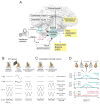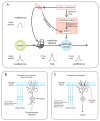The vestibular system: multimodal integration and encoding of self-motion for motor control
- PMID: 22245372
- PMCID: PMC4000483
- DOI: 10.1016/j.tins.2011.12.001
The vestibular system: multimodal integration and encoding of self-motion for motor control
Abstract
Understanding how sensory pathways transmit information under natural conditions remains a major goal in neuroscience. The vestibular system plays a vital role in everyday life, contributing to a wide range of functions from reflexes to the highest levels of voluntary behavior. Recent experiments establishing that vestibular (self-motion) processing is inherently multimodal also provide insight into a set of interrelated questions. What neural code is used to represent sensory information in vestibular pathways? How do the interactions between the organism and the environment shape encoding? How is self-motion information processing adjusted to meet the needs of specific tasks? This review highlights progress that has recently been made towards understanding how the brain encodes and processes self-motion to ensure accurate motor control.
Copyright © 2012 Elsevier Ltd. All rights reserved.
Figures





Similar articles
-
Multimodal integration of self-motion cues in the vestibular system: active versus passive translations.J Neurosci. 2013 Dec 11;33(50):19555-66. doi: 10.1523/JNEUROSCI.3051-13.2013. J Neurosci. 2013. PMID: 24336720 Free PMC article.
-
Selective processing of vestibular reafference during self-generated head motion.J Neurosci. 2001 Mar 15;21(6):2131-42. doi: 10.1523/JNEUROSCI.21-06-02131.2001. J Neurosci. 2001. PMID: 11245697 Free PMC article.
-
Signal processing in the vestibular system during active versus passive head movements.J Neurophysiol. 2004 May;91(5):1919-33. doi: 10.1152/jn.00988.2003. J Neurophysiol. 2004. PMID: 15069088 Review.
-
Statistics of the vestibular input experienced during natural self-motion: implications for neural processing.J Neurosci. 2014 Jun 11;34(24):8347-57. doi: 10.1523/JNEUROSCI.0692-14.2014. J Neurosci. 2014. PMID: 24920638 Free PMC article.
-
Vestibular system: the many facets of a multimodal sense.Annu Rev Neurosci. 2008;31:125-50. doi: 10.1146/annurev.neuro.31.060407.125555. Annu Rev Neurosci. 2008. PMID: 18338968 Review.
Cited by
-
Postural Effects of Vestibular Manipulation Depend on the Physical Activity Status.PLoS One. 2016 Sep 14;11(9):e0162966. doi: 10.1371/journal.pone.0162966. eCollection 2016. PLoS One. 2016. PMID: 27627441 Free PMC article.
-
Motor and Visuospatial Attention and Motor Planning After Stroke: Considerations for the Rehabilitation of Standing Balance and Gait.Phys Ther. 2015 Oct;95(10):1423-32. doi: 10.2522/ptj.20140492. Epub 2015 Apr 30. Phys Ther. 2015. PMID: 25929533 Free PMC article.
-
The Effect of Cognitive Tasks on the Ocular Vestibular Evoked Myogenic Potentials in Healthy People.Iran J Otorhinolaryngol. 2020 Sep;32(112):311-317. doi: 10.22038/ijorl.2019.39322.2301. Iran J Otorhinolaryngol. 2020. PMID: 33014908 Free PMC article.
-
Vestibulo-ocular reflex suppression during head-fixed saccades reveals gaze feedback control.J Neurosci. 2015 Jan 21;35(3):1192-8. doi: 10.1523/JNEUROSCI.3875-14.2015. J Neurosci. 2015. PMID: 25609633 Free PMC article.
-
Task, muscle and frequency dependent vestibular control of posture.Front Integr Neurosci. 2015 Jan 9;8:94. doi: 10.3389/fnint.2014.00094. eCollection 2014. Front Integr Neurosci. 2015. PMID: 25620919 Free PMC article. Review.
References
-
- Angelaki DE, Cullen KE. Vestibular system: the many facets of a multimodal sense. Annual review of neuroscience. 2008;31:125–150. - PubMed
-
- Eatock RA, Songer JE. Vestibular Hair Cells and Afferents: Two Channels for Head Motion Signals. Annual review of neuroscience. 2011;34:501–534. - PubMed
-
- Armand M, Minor LB. Relationship between time- and frequency-domain analyses of angular head movements in the squirrel monkey. Journal of computational neuroscience. 2001;11:217–239. - PubMed
Publication types
MeSH terms
Grants and funding
LinkOut - more resources
Full Text Sources

